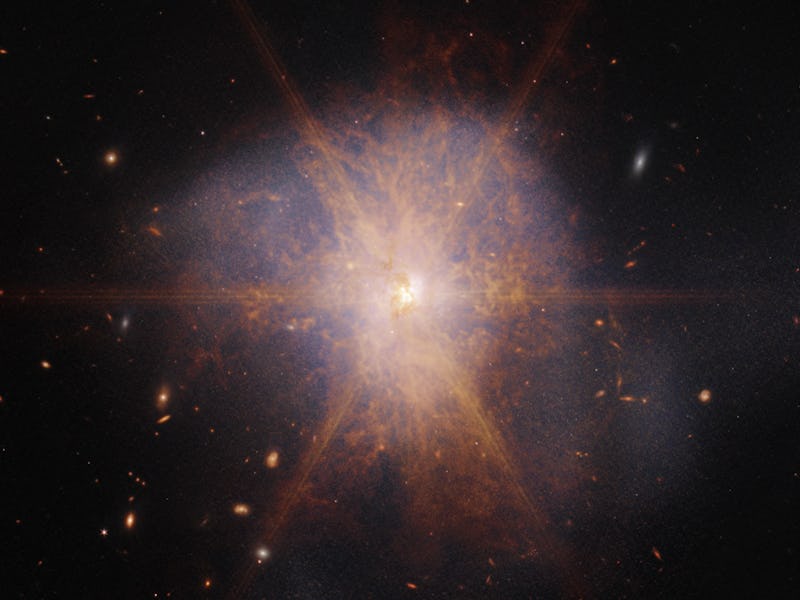Dazzling! Webb Space Telescope Image Shows Bright Galactic Collision
Behold Arp 220, a pair of galaxies who’ve sprouted 200 star clusters and a scene brighter than all the light of the Milky Way.

A lot of gas, the rough equivalent to all the gas found within the Milky Way galaxy, has crammed into a region just 5 percent its diameter. In a new NASA image from the James Webb Space Telescope (JWST), the observatory captured the spectacular cosmic collision taking place in the middle of a bright object in a nearby galaxy.
Galaxies are a work in progress, evolving over time and shedding some features while sculpting all new ones. In the case of the two spiral galaxies in the scene dubbed Arp 220, their gas is transforming into a bountiful collection of stars. But that’s because the galaxies have entered a perilous situation, where they’ve crashed into one another. Astronomers think they began colliding 700 million years ago, and now, their cores are a teensy 1,200 light years apart. For reference, the Milky Way and the Andromeda galaxy are separated by a 2.5 million-light-year stretch of space.
These colliding galaxies “ignited a tremendous burst of star birth,” according to NASA. This image comes from the NASA, Canadian Space Agency and European Space Agency observatory, the James Webb Space Telescope, which collected data from object Arp 220 with its Mid-Infrared Instrument and its Near-Infrared Camera.
Thanks to all its incredible starburst activity, this pair of interacting galaxies, located in the constellation Serpens (the Serpent) about 250 million light-years away, shines as bright as 1 trillion Suns, according to JWST officials. Our own galaxy, by comparison, has a fraction of that luminosity, at 10 billion times the Sun.
Since JWST views the Universe in infrared, its instruments peer into veils of dust to reveal these telltale galactic hearts. The image published Monday even reveals rings of star formation around each spiral galaxy’s core.
JWST launched at the end of 2021 to sail around 1 million miles past Earth, at a gravitationally-stable spot that allows it to stay cool and free of interference. Thanks to this distance, three of the four JWST instruments that survey the Universe can operate at their ideal, distraction-less temperature, about 37 Kelvin, according to NASA. That’s roughly -236 degrees Celsius or -393 degrees Fahrenheit. This trio includes the observatory’s Near-Infrared Camera (NIRCam), half the imaging instrument team that made this new image possible.
But the other instrument that produced this view of Arp 220, the Mid-Infrared Instrument (MIRI), needs to be even colder. It must operate at less than 7 kelvin (-266 degrees Celsius or -447 degrees Fahrenheit). To do that, engineers installed a cryocooler on JWST to bring MIRI’s temperature down to where it needs to be.
Studying galaxies in all their oddities and transformations is a major science goal of the observatory. This summer, JWST will celebrate its first year of cosmic science.
This article was originally published on